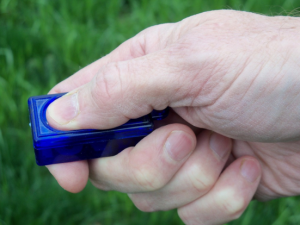The Joy of Shaping In Dog Training

There are few things more exciting for a trainer than working with a dog on shaping a new behavior through clicker training. From teaching the dog to lie down on his bed, to retrieving objects, or flipping a light switch on; shaping has endless fun and useful applications. Just like a painter who slowly creates a beautiful landscape, adding one color at a time on a white canvas. The trainer, step by step, brings to life a new behavior in the animal’s repertoire.
Shaping in its purest form refers to breaking down a behavior into tiny moves and reinforcing the animal for each little step in the right direction. There are other ways to teach a dog a new behavior, from physically manipulating him, to luring, capturing, or targeting, and I’ll cover those techniques in future blogs. Some trainers may choose to apply or combine different techniques depending on the dog or the behavior. Others, consider shaping to be the best form of training and will use it as the preferred training technique. I personally find it easier and quicker to jump-start some behaviors through luring, like ‘sit’ or ‘down’, then quickly transition to shaping. The combination of those two techniques is sometimes referred to as guided shaping. But whenever a dog shows resistance to luring, or for more complex behaviors, shaping right from the start is a great way to get results. Shaping could also come in handy to fine tune certain elements of a behavior, straightening a ‘heel’ for instance, or defining a better ‘hold’ or to get a dog to perform behaviors that he’s initially uncomfortable with, like getting in a crate.
A good shaping session requires three main ingredients:
1. the dog needs to be motivated to offer behaviors. Since pleasant consequences increase the chances of an animal to repeat the rewarded behavior (operant conditioning), using treats that the dog will like is a must.
2. Since we’re rewarding small increments at a time, the more precise we are with the timing of the reward, the easier it is for the animal to understand which movement to repeat. The use of a clicker, a whistle or a word, initially paired with a treat through a process called classical conditioning, will allow us to communicate more efficiently with the animal. When the dog makes any movement in the right direction, the conditioned sound, or bridging stimulus, is produced and he gets rewarded with a treat. As we reward specific movements, like a look in a certain direction, or the slight movement of a paw, there is always a certain amount of variation. The dog may move a little faster, a little closer, a little higher, etc… This variability is what will allow us to pick and chose the behaviors that little by little will lead to end result.
3. A calm and positive attitude from the trainer. Dogs are very sensitive to our moods (You can’t lie to your dog), so a sigh or other sign of frustration, or worse, of irritation, will generate stress in the dog that may start hesitating in offering behaviors. Shaping should always be fun, interesting and positive for the dog or its effectiveness will be diminished.
One behavior that is commonly shaped is sending the dog to his bed. With a clicker and treats in hand, the trainer will place the bed on the floor and start clicking for any attention the dog will give to the bed. First a look, then one paw, two paws, all four, then a sit and finally a down. By increasing the criteria little by little, while keeping the sessions short and making sure the dog is rewarded often enough that he stays motivated, we’ll have a dog that is happy to go lie on his bed. Once the behavior achieved, the trainer will associate a cue of his or her choice. With a little extra work (adding some duration, distractions and generalization to different areas), the owner will have a reliable way to send and keep his dog on his bed.
When applied well by the trainer, like a game of hot and cold, the animal will experiment with different movements until finding the ones that gets rewarded. That’s what makes shaping so unique and so different from any other method. The animal’s mind is actively engaged in the process! No doubt, you can get a dog to sit by following a treat held above his head or applying pressure on his rear end, but none of those methods require much thinking from the dog. When actively looking for ways to get the trainer to reward him, the learning experience is enhanced.

It seems that using a clicker over other bridging stimulus may decrease that overall training time (Wood, 2007) of a complex behavior, however, when training a simple behavior, another study indicates that this effect no longer holds true (Smith & Davis, 2008), but that the use of a clicker makes the behavior significantly more resistant to extinction.
Overall, shaping promotes creativity and focus in dogs and the more behaviors the dog learns this way, the faster he’ll figure out new ones. Shaping is a great way to teach complex behaviors to all sorts of animals, including those that we’d rather not get too close to (like lions or tigers), from fish to horses, and even animal-looking robots (Kaplan & al., 2002). Shaping also strengthens the animal/human relationship as they learn to collaborate in the task. With a valid communication system, the chances of confusion and frustration are reduced, leaving the experience fun and interesting for both the animal and the trainer.
Jennifer Cattet, Ph.D.


Leave a comment